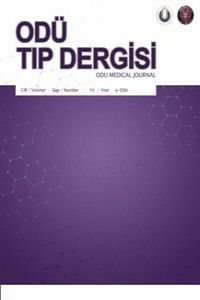Ordu Üniversitesi Eğitim ve Araştırma Hastanesi Yenidoğan İşitme Tarama Testi 2 Yıllık Sonuçları
yenidoğan, işitme kaybı, işitme tarama, yenidoğan, işitme kaybı, işitme tarama
Ordu University Training and Research Hospital 2-Year Results of Newborn Hearing Screening Tests
ewborn, hearing loss, screening, ewborn, hearing loss, screening,
___
- 1.Thompson DC, McPhillips H, Davis RL, Lieu TL, Homer CJ, Helfand M. Universal newborn hearing screening: summary of evidence. JAMA 2001; 286: 2000-10.
- 2. Nekahm D, Weichbold V, Welzl-Mueller K, Hirst-Stadlmann A. Improvement in early detection of congenital hearing impairment due to universal newborn hearing screening. Int J Pediatr Otorhinolaryngol 2001; 59: 23-8.
- 3. Kennedy CR, Kimm L, Dees DC, et al. Otoacoustic emissions and auditory brainstem responses in the newborn. Arch Dis Child 1991; 66: 1124-9.
- 4. Oudesluys-Murphy AM, van Straaten HL, Bholasingh R, van Zanten GA. Neonatal Hearing screening. Eur J Pediatr 1996; 155: 429-35.
- 5. Mencher GT, Davis AC, DeVoe SJ, Beresford D, Bamford JM. Universal neonatal hearing screening: past, present, and future. Am J Audiol 2001; 10: 3-12.
- 6. Kennedy C, McCann D, Campbell MJ, Kimm L, Thornton R. Universal newborn screening for permanent childhood hearing impairment: an 8-year follow-up of a controlled trial. Lancet 2005; 366: 660-2.
- 7. Hahn M, Lamprecht-Dinnesen A, Heinecke A, et al. Hearing scre ening in healthy newborns: feasibility of different methods with regard to test time. Int J Pediatr Otorhinolaryngol 1999; 51: 83-9.
- 8. Chu K, Elimian A, Barbera J, Oqburn P, Spitzer A, Quirk JG . Antecedents of newborn hearing loss. Obstet Gynecol 2003; 101: 584-8.
- 9. Joint Committee on Infant Hearing position statement 1982. Ear Hear 1983; 4: 3-4.
- 10. Joint Committee on Infant Hearing, American Academy of Audiology, American Academy of Pediatrics, American SpeechLanguage-Hearing Association, and Directors of Speech and Hearing Programs in State Health and Welfare Agencies. Year 2000 position statement: principles and guidelines for early hearing detection and intervention programs. Pediatrics 2000; 106: 798-817.
- 11. Bolat H, Bebitoglu FG, Ozbas S, Altunsu AT, Kose MR. National newborn hearing screening program in Turkey: struggles and implementations between 2004 and 2008. Int J Pediatr Otorhinolaryngol 2009; 73: 1621-3.
- 12. Hahn M, Lamprecht-Dinnesen A, Heinecke A, et al. Hearing screening in healthy newborns: feasibility of different methods with regard to test time. Int J Pediatr 13. Otorhinolaryngol 1999; 51: 83-89.
- 14. Thompson DC, McPhillips H, Davis RL, Lieu TL, Homer CJ, Helfand M. Universal newborn hearing screening: summary of evidence. JAMA 2001; 286: 2000-2010.
- 15. Doyle KJ, Burggraaff B, Fujikawa S, Kim J. Newborn hearing screening by otoacoustic emissions and automated auditory brainstem response. Int J Pediatr Otorhinolaryngol 1997; 41: 111-119.
- 16. Thornton AR, Kimm L, Kennedy CR. Methodological factors involved in neonatal screening using transientevoked otoacoustic emissions and automated auditory brainstem response testing. Hear Res 2003; 182: 65-76.
- 17. Gabbard SA, Northern JL, Yoshinaga-Itano C. Hearing screening in newborns under 24 hours of age. Semin Hear 1999; 20: 291-305.
- 18. Kemp DT, Ryan S, Bray P. A guide to effective use of otoacoustic emissions. Ear Hear 1990; 11: 93-105.
- 19. White KR, Vohr BR, Behren TR. Universal newborn hearing screening using transient evoked otoacoustic emissions: results of Rhode Island Hearing Assessment Project. Semin Hear 1993; 14: 18-29.
- 20. Joint Committee on Infant Hearing 1990 position statement. ASHA Suppl 1991; 5 : 3-6.
- 21. Joint Committee on Infant Hearing. Year 2000 position statement: principles and guidelines for early hearing detection and intervention programs. Am J Audiol 2000; 9: 9- 29.
- 22. Vohr BR, Carty LM, Moore PE, Letourneau K. The Rhode Island Hearing Assessment Program: experience with statewide hearing screening (1993-1996). J Pediatr 1998; 133: 353-7.
- 23. Joint Committee on Infant Hearing 1994 Position Statement. American Academy of Pediatrics Joint Committee on Infant Hearing. Pediatrics 1995; 95: 152-6.
- 24. Ghirri P, Liumbruno A, Lunardi S, et al. Universal neonatal audiological screening: experience of the University Hospital of Pisa. Ital J Pediatr 2011; 37: 16.
- 25. Genç GA, Başar F, Kayıkçı ME, ve ark. Hacettepe Üniversitesi yenidoğan işitme taraması bulguları. Çocuk Sağlığı ve Hastalıkları Dergisi 2005; 48: 119-24.
- 26. Genç GA, Ertürk BB, Belgin E. Yenidoğan işitme taraması: başlangıçtan günümüze. Çocuk Sağlığı ve Hastalıkları Dergisi 2005; 48: 109-18.
- 27. Çelik İ, Canpolat FE, Demirel G, ve ark. Zekai Tahir Burak Kadın Sağlığı ve Araştırma Hastanesi yenidoğan işitme tarama sonuçları ve hastaların değerlendirilmesi. Türk Ped Arş 2014; 49: 138-41.
- 28. Ovet G, Balci YI, Canural R, et al. Our results of the hearing screening. Journal of Adnan Menderes University Medical Faculty 2010; 11: 27-9.
- 29. Kayiran SM, Genc E, Erdil A, Gurakan BA. Results of American Hospital newborn hearing screenin program. Turk Ped Arch 2009; 44: 135-7.
- 30. Renda L, Özer E, Renda R. Ankara Polatlı Devlet Hastanesi yenidoğan işitme taraması programı: 6 yıllık sonuçlar. Pamukkale Tıp Dergisi 2012; 5: 123-7.
- 31. Eryılmaz A, İleri O, Çakın M, ve ark. Uludağ Üniversitesi yenidoğan işitme taraması sonuçları. UÜ Tıp Fakültesi Dergisi 2009; 35: 27-9
- Yayın Aralığı: Yılda 3 Sayı
- Başlangıç: 2014
- Yayıncı: Ordu Üniversitesi
Ordu Üniversitesi Eğitim ve Araştırma Hastanesi Yenidoğan İşitme Tarama Testi 2 Yıllık Sonuçları
Abdullah ERDİL, Emine YURDAKUL ERTÜRK, Abdullah DAĞLI
Torasik Çıkış Sendromunda Yanlış Tanı ve Tedavi: Olgu Sunumu
Onuralp SEFEROĞLU, Ülkü KARAMAN, İrem ALDEMİR, Zeynep KOLÖREN
Perikardiyal kistlerde total cerrahi eksizyonun etkinliği
Burçin ÇELİK, Yasemin Bilgin BÜYÜKKARABACAK, Mehmet Gökhan PİRZİRENLİ, Ayşen Taslak ŞENGÜL
Osman BEKTAŞ, Zeki Yüksel GÜNAYDIN, Ahmet KAYA
Levent ÖZDEMİR, Burcu ÖZDEMİR, Zulal ÖZBOLAT, Ali ERSOY, Sema Nur ÇALIŞKAN, Gökhan BÜYÜKBAYRAM, Suat DURKAYA
Varikosel Hastalarında Klinik, Laboratuvar ve Doppler Ultrasonografi Bulgularının Değerlendirilmesi
Muammer AKYOL, Tülin ÖZTÜRK, Gülen BURAKGAZİ, Hanefi YILDIRIM, İrfan ORHAN
Ordu İlinde Hamilelik Döneminde Önemli Viral Patojenlerin Araştırılması
Yeliz ÇETİNKOL, Mustafa Kerem ÇALGIN, Arzu ALTUNÇEKİÇ YILDIRIM
İnmede Erken Dönem Rehabilitasyon
Afyonkarahisar ve Bölgesinde Safra Kesesi Taşı ve Metabolik Sendrom Birlikteliği
Mustafa ÖZSOY, Bahadır CELEP, Ogün ERŞEN, Ahmet BAL, Taner ÖZKECECİ, Sezgin YILMAZ, Yüksel ARIKIN
